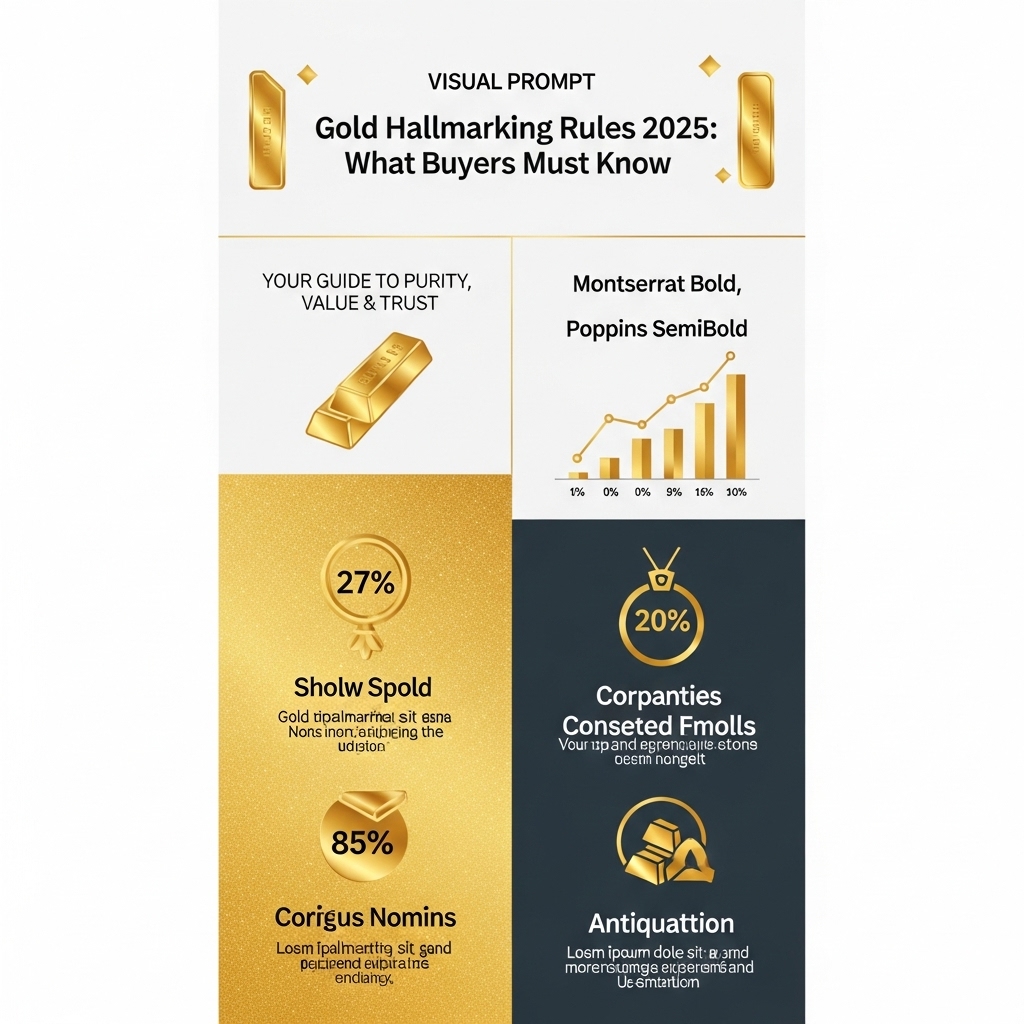Gold Hallmarking Rules 2025: What Buyers Must Know
Gold has always glittered, but in today’s volatile economic climate, its shine is brighter than ever. With inflation concerns looming and geopolitical tensions rising, the precious metal has consistently proven its mettle as a resilient store of value and a strategic portfolio diversifier. We’ve seen gold prices surge, attracting both seasoned investors and new entrants eager to capitalize on its upward trajectory and inherent stability. But as you navigate this shimmering market, one question becomes paramount: how can you be absolutely certain your gold investment is as pure and valuable as it claims to be?
This question is precisely why the upcoming ‘Gold Hallmarking Rules 2025’ are a critical development for every gold investor. These new regulations are designed to bring enhanced transparency and uniformity to the gold market, directly impacting the authenticity and ultimate value of your precious metal holdings. In this comprehensive guide, we’ll delve into the specifics of these crucial updates, explaining what changes are coming, how they affect your gold purchases, and what proactive steps you need to take to safeguard your investments.
Understanding these rules isn’t just about compliance; it’s about protecting your financial future. For investors, authenticity directly translates to market value and liquidity. Purity guarantees ensure you’re getting exactly what you pay for, mitigating risks of fraud and ensuring a smoother resale process down the line. By staying informed about the 2025 hallmarking standards, you empower yourself to make smarter, more secure gold investments, maximizing your financial benefits and reinforcing gold’s role as a cornerstone of your wealth-building strategy. Don’t let uncertainty diminish your golden opportunities – let’s ensure your investments truly shine.
Gold Market Analysis and Key Insights
The upcoming Gold Hallmarking Rules 2025 will significantly impact the gold investment landscape, enhancing transparency and trust in physical gold as an asset class. For buyers considering gold as an investment, understanding the current market dynamics alongside these new regulations is crucial.
Enhancing Investor Confidence & Liquidity
The mandatory hallmarking of gold jewellery and artefacts from 2025 is poised to bolster investor confidence. By ensuring certified purity, these rules mitigate risks associated with adulteration or under-caratage, making physical gold a more reliable and secure investment. This standardization improves liquidity, as buyers and sellers can transact with greater assurance regarding the metal’s true value, potentially narrowing the spread between buying and selling prices and facilitating smoother resale.
Current Market Dynamics & Safe-Haven Appeal
Gold prices have demonstrated remarkable resilience, often trading near historical highs driven by global economic uncertainties. Data indicates gold’s upward trajectory is influenced by persistent inflation concerns, geopolitical tensions, and fluctuating interest rates. In times of market volatility, gold consistently reinforces its role as a traditional safe-haven asset, offering a hedge against currency depreciation and equity market downturns, making it an attractive component for portfolio diversification.
For investors, the benefits of gold include its proven ability to preserve wealth and act as an inflation hedge. However, considerations involve storage and insurance costs for physical gold, and understanding the premium over spot prices. Expert recommendations suggest allocating 5-15% of a diversified portfolio to gold. Crucially, post-2025, investors must prioritize purchasing only BIS-hallmarked gold to ensure authenticity and protect their investment’s future value. This adherence to regulated purity will be paramount for long-term growth and ease of liquidation.

Gold Investment Strategies and Options
Beyond simply owning gold jewellery, understanding various investment avenues and integrating them into a sound strategy is crucial for buyers. Gold, traditionally a safe-haven asset, offers diverse options.
Physical Gold investments primarily involve gold bars and coins. While providing tangibility and direct ownership, these require secure storage and insurance, adding costs. Hallmarking, especially with the 2025 rules, ensures purity and enhances resale value. Jewellery, due to high making charges and potential wear, is generally less suitable for pure investment than bullion.
Digital and Paper Gold alternatives offer convenience and often superior liquidity. Gold Exchange Traded Funds (ETFs) allow investors to buy units representing physical gold without handling the physical asset. Sovereign Gold Bonds (SGBs), issued by the government, are a highly attractive option, offering an annual interest payment and capital gains tax exemption upon maturity. Digital Gold platforms enable purchasing gold in small denominations, ideal for regular, small investments.
For risk assessment and portfolio allocation, gold serves primarily as a hedge against inflation and economic instability, rather than a primary growth engine. Financial advisors often recommend allocating 5-15% of a diversified portfolio to gold, depending on an individual’s risk appetite and prevailing economic outlook. It’s important to note that gold, unlike stocks or bonds, typically does not generate income (with SGBs being a notable exception).
Comparing methods, physical gold appeals to those valuing direct ownership, but digital options excel in ease of transaction, lower storage risks, and often better pricing transparency. SGBs stand out for their sovereign guarantee and tax efficiency.
Regarding market timing, while gold prices fluctuate, it is generally considered a long-term investment. Investors often employ strategies like dollar-cost averaging (investing fixed amounts regularly) to mitigate volatility, rather than attempting to perfectly time market highs and lows. Gold’s role is more about providing stability during periods of economic uncertainty.
Market Performance and Outlook
Historically, gold has proven to be a resilient asset, often acting as a safe haven during economic downturns and inflationary periods. It demonstrated significant appreciation post-2008 and achieved record highs in recent years, reflecting global uncertainties and persistent inflation concerns. This robust performance underscores its enduring appeal as a store of value.
Currently, the gold market navigates a complex interplay of factors. While elevated inflation typically supports gold, rising interest rates by major central banks can temper its appeal, as gold offers no yield. Geopolitical tensions, volatile equity markets, and the fluctuating strength of the US dollar further contribute to its price dynamics. Despite these headwinds, gold has maintained a strong base, driven by sustained investment and central bank buying.
Looking ahead, the outlook for gold remains generally positive. Persistent inflation, the potential for global economic slowdowns, and ongoing geopolitical instabilities are expected to underpin demand. While interest rate trajectory will remain a key determinant, physical gold demand, particularly in major consumer markets, is projected to stay robust. The Gold Hallmarking Rules 2025 are anticipated to enhance buyer trust and transparency, potentially stimulating organized market purchases. Economic factors such as real interest rates, the US dollar’s value, and central bank monetary policies will continue to dictate its trajectory.
Frequently Asked Questions About Gold Investment
What is Gold Hallmarking and why is it mandatory from 2025?
Hallmarking is a quality certification system that verifies the purity of gold jewellery. From 2025, it becomes mandatory for all gold articles sold by jewellers in India. This ensures buyers receive the declared purity, promoting transparency, building consumer trust, and protecting against fraudulent sales of impure gold.
What specific hallmarks should I look for on gold jewellery post-2025?
Buyers must look for three key marks: the BIS (Bureau of Indian Standards) logo, the purity in carats (e.g., ’22K916′ for 91.6% pure 22-carat gold or ’18K750′ for 75% pure 18-carat gold), and the HUID (Hallmarking Unique Identification) number, which is a six-digit alphanumeric code unique to each item.
How do the new rules enhance protection for gold investors?
The 2025 rules, especially with the mandatory HUID, offer unparalleled transparency and traceability for every gold article. Investors are assured of the exact gold purity at the time of purchase, significantly reducing risks of adulteration and making it easier to verify authenticity, thereby safeguarding their investment value.
Can I still sell or exchange my old, unhallmarked gold after 2025?
Yes, you can still sell or exchange your old, unhallmarked gold. The new hallmarking rules primarily apply to new gold items being sold by jewellers. When you sell or exchange old gold, its purity will typically be assessed by the jeweller using standard testing methods, and its value determined accordingly.
Will mandatory hallmarking increase the price of gold jewellery significantly?
While there is a nominal hallmarking charge per item levied by the jeweller (typically a few rupees), this is a very small percentage of the overall gold value. The primary factors influencing gold jewellery prices remain the daily gold market rate and making charges. The added cost for purity assurance is minimal.

Final Thoughts on Gold Investment
As we approach 2025, understanding the updated gold hallmarking rules is paramount for every investor. These regulations are designed to bolster consumer trust and ensure the purity of your gold holdings, protecting you from potential fraud. The key takeaway is clear: always prioritize BIS hallmarked jewellery with the unique HUID. This verifies the metal’s purity and authenticity, safeguarding your hard-earned investment. Gold continues to be a resilient asset, offering stability and hedging against inflation. However, its true value lies in its certified purity. Therefore, our final recommendation is to invest confidently, but always with vigilance. Make hallmarking your non-negotiable standard when purchasing gold. Empower yourself with knowledge and ensure every gold acquisition is a secure and valuable addition to your portfolio.